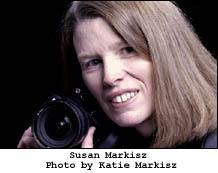Ballet Preljocaj
There are no do-overs. In real life, we get to learn from our mistakes, and fortunately this holds true for newspaper assignments as well, but, if we don't get it right the first time 'round, we'd better have a good excuse for our editors. The assignment was the New York premiere
of the Ballet Preljocaj. Not the classical kind with tulle costumed
prima donnas, but rather a modern, passionate, erotic, ferocious
and intense dance, the kind that is palpable and awesome to watch, but
miserable to shoot, the kind that's almost impossible unless you're shooting
at 3200 or 6400 ASA...and therein lies the lesson.
The editor had suggested not to shoot too
tight. For most of the performance, I was shooting 800 pushed
to 1600 at exposures ranging from wide open to f4 at 1/15th and 1/60th.
Occasionally, I thought I'd nailed peak action at about 1/125th, but I
knew I was borderline on the action part. The extreme, blunt and split-second
movements were probably the sports equivalent of a basketball game.
When the picture ran very small a couple of days later on the front page of the Arts section, with a major review, my first thought was: "Oh well..." But then, this all-encompassing internal lambasting took place that really shook me up. My internal dialogue went something like this: "Geez, Susan, you shot way too much film, you rented a lens breaking even on the day, they run a 2 x 2 picture and no backstage shots and then, while editing your film on the light table, the photo that ran in the paper didn't even occur to you. You can't even EDIT!" Complete self annihilation. It didn't seem to be an ego thing about the size of the photo or that it was a small picture. I had this nagging sensation. I knew this was an important review and some little voice inside started telling me it simply wasn't a space issue that lead the editor to run the picture so small. The review mentioned this one scene over and over again, in which I had gotten maybe one usable image. Naturally, this was the scene that I hardly photo graphed. It's probably safe to say I took a few pictures and then waited for it to be over. I emailed my buddy again and told him what my "inner critic" had said. He wrote me back:
I felt a little better after reading his email. The following day, an editor of another section called me and told me the arts editor had told him that I had some really nice outtakes from the ballet and he was going to use one in Sunday's paper. "A-ha," I thought, "my pictures couldn't have been that bad." Wrong. A couple of days later, I ran into the Arts editor in the newsroom, who, when I said that I had enjoyed shooting the Ballet, remarked that I hadn't given them what they wanted, referring to the assigning editor and the writer. Gulp. "In what sense?" I wanted to know. She asked me if I'd read the review and I told her of course I had. Then I launched into a defensive tactic that I really disliked. Difficult lighting, dancers that "snap in and out of poses," and "tear with grand whiplash truculence." I quoted from reviewer Anna Kisselgoff, virtually impossible to photograph, I maintained. Though the writer described many scenes for which I had photographs, I didn't have the ones she wanted. The Arts editor suggested I review my take again. In hindsight, I might have rated my film at 3200. It's still doubtful that I'd have stopped the grand whiplash action the reviewer described. In some of the more brightly lit scenes, I could have stopped down and increased my shutter speed, possibly capturing a little more movement. My pictures were fairly static and didn't describe the vitality of the piece. Hindsight is 20/20. But there are no excuses. And there are no do-overs. Two or more of the following statements may be true: This is a manic business. I need to develop a thicker skin. And I think I need a shrink. Susan B. Markisz
|
